I was walking past my favorite fast food chain today when I remembered reading a news a few days ago that several fast food chains in the US – namely Chipotle Mexican Grill, McDonald and Burger King have decided to raise prices for their products across their menus due to rising raw material and labor costs.
U.S Consumer Price Index (CPI), which represents a basket including food, energy, groceries, housing and sales across a spectrum of goods, rose 5% year on year in May. This represents their fastest pace of increase in nearly 13 years. The last CPI gain which was above 5% was dated back in August 2008 when CPI gains 5.3% that year.
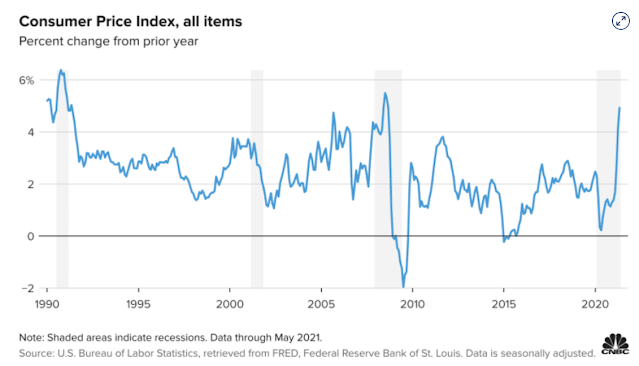 |
| Source: CNBC |
For a long time in this decade, we have grappled with the expectation and live with low inflation since the Great Financial Crisis in 2008. While many are still recovering from the post-pandemic era, there are still an obvious clear trend of laggard for job availability and rising wages, which may dampen the overall recovery of the economy before they can call it a success.
This can create a disparity between expectation and reality in purchasing power, and while nominal income may seem to increase on the surface, real income may actually suffer. This can then result in an overall drop in the standard of living.
Why is Inflation bad for the stock market?
Long-lasting episodes of high inflation are often the result of imbalance monetary policy.
For many years, central banks have kept interest rates near to zero which boosted productive borrowings from companies to grow and expand its offerings. This resulted in an overall increase in job creations and demand to purchase, which pushed many stock prices to its record high.
Unfortunately, the Federal Reserve has not acted fast enough to restore the interest rates when economy is recovering and many of these fueled money has gone into investment and speculative assets rather than concessionary spending, leading to inflation expectation over time.
Businesses have for many years enjoyed low costs of borrowings and a sudden increase in the interest rates will send mixed signal to the economy as companies have to cope with higher cost of borrowings. Risk premium expectation will also increase which will lead to a lower valuation of its business.
Inflation. Inflation..Inflation
Michael Burry – who famously shot to fame by betting against mortgage securities leading up to the Great Financial Crisis and was depicted in a movie called “The Big Short” (I would strongly recommend you to watch it if you haven’t watched the movie) revealed his positions in a funds he held through Scion Asset Management in the recent 13F quarterly filing.
On the 21st Feb 2021, he shot a warning to the rest of the market in his tweet – a prediction he has similarly taken in the past leading up to the Great Financial Crisis which he calls it as “no one listened”.
He tweeted:
“People say I didn’t warn last time. I did, but no one listened. So I warn this time. And still, no one listens. But I will have proof I warned.”
 |
| Source: Twitter |
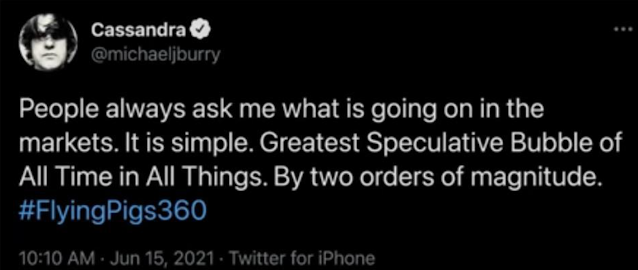 |
| Source: Twitter |
Further, he has also compared the upcoming US inflation to the hyperinflation that happened in Germany during the 1920s and what the consequences that the country should be prepared to pay for. In his most recent tweet, he also called the market the greatest speculative bubble of all time is forming at the moment.
In the recent 13F Filing (ended March 2021), he shared his open positions and direct inflation strategy that includes some of his positions profiting from the rise in inflation expectation:
 |
| Source: Scion’s 13F Filing |
The most prominent one is his positions on the Put options Ishares 20+ Year Treasury Bond ETF (TLT) – which represents 12.7% of portfolio holdings and also one of his largest current stake (other than the short position on Tesla).
This particular ETF tracks the investment results of the ICE U.S. Treasury 20+ Year Bond Index (the “underlying index”) and performance of the U.S Treasury that have a remaining maturity of greater than twenty years.
A rising inflation over time will force the hands of the Federal Reserve to increase interest rates earlier than expected which would lead to a decline in the value of these bonds. Longer maturity term bonds would be more sensitive to changes in the interest rates which would likely give way to more volatility in the price action of these bonds.
 |
| Source: 3Fs Working Compilation |
Burry has used options in majority of his positions in order to magnify the return of his investment, but has also taken more risks should the thesis gone the other way against him.
Other than TLT, he has also taken a couple of positions in the call option ProShares UltraShort 20+ Year Treasury (TBT) and ProShares UltraPro 20+ Year Treasury (TTT) which is an inverse of the bond ETF so he is betting that these ETF will go up. He uses call option further in order to magnify his positions even more to signal his conviction.
P.S: TBT UltraShort goes up 2x when bond index goes down and TTT UltraPro goes up 3x when bond index goes down.
Most of his positions should be largely profitable by now and while inflation fears have tapered a little in recent weeks depicted by a drop in treasury yields, Burry should still be sitting quite comfortably in the black.
If you are interested to take a position in TLT, you can take advantage of the offer from Phillip MetaTrader5 and open a direct short position. This will put you in a similar position with the put option which Michael Burry undertakes.
Do note that there are no limitations on how much users should trade and users are allowed to trade as small as 1 ETF CFD on the platform. There is also no minimum fee incurred on the user and commission trading is zero.
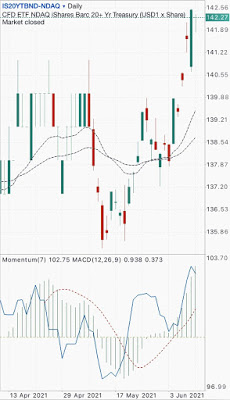 |
| Source: Phillip MetaTrader5 (iShares Barc 20+ Yr Treasury ETF) |
Alternative Investment: Energy Select Sector SPDR ETF (XLE)
An alternative investment that will be a good hedge against inflation is an exposure to Energy stocks.
XLE is an ETF made up of the 23 largest Energy companies in the S&P 500 – valued today at around $26 billion of assets under management. It comprises of some of the largest name companies such as Exxon Mobil (XOM), Chevron (CVX) and ConocoPhillips (COP).
Energy is one of the commodities that correlates strongly to inflation movement. In the past 5 years, you can see that whenever there is a hint of inflation spikes, energy commodities values also went up subsequently.
The underlying reason for this is because oil price setting is a balance between demand and supply and with inflation trending up, the likelihood of oil following suit is very probable. These companies included in the ETF would then be direct beneficiaries of rising oil prices.
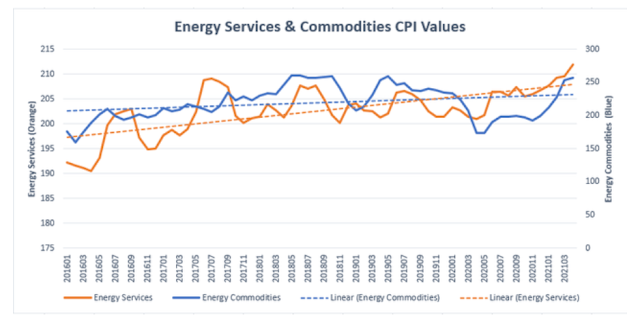 |
| Source: U.S Labor of Statistics |
A quick benchmark of the mentioned ETF against S&P shows that it came out a clear winner this year, returning over 47% as compared to S&P which only returned 13%. Forward valuation for the ETF is also modest at around 20.8x and is still below pre-Covid days.
 |
| Source: 3Fs Working Compilation |
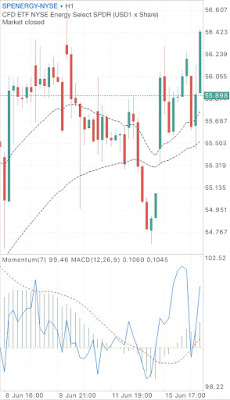 |
| Source: Phillip MetaTrader5 (Energy Select Sector SPDR ETF)
|
Conclusion
The takeaway here is that fast and rising inflation can hit the fan really hard when and should it comes and there will hardly be any place to run and take cover for it.
In the past few weeks, prominent figures such as Michael Burry, Warren Buffett, Ray Dalio and Bill Ackman have all warned about an unprecedented rise in inflation this year which the Fed continued to brush away, giving the market assurance that these inflation increases are likely to be temporary in nature and will stabilize soon.
But if there is anything, the recent data in the past couple of months tells us otherwise and it is better to be safe than sorry.
Do take note that the two abovementioned ETF CFDs only require 20% of the margin requirement which grants your capital a greater efficiency. For instance, if you decide to purchase 100 shares of the Energy Select Sector SPDR ETF, you would usually require a capital of 100 x $55 = $5,500. In this platform, you would only require 20% of the $5,500 = $1,100 to purchase that same 100 shares.
Do check out the full comprehensive list of all the available ETF CFDs in this link here.
If you are interested in downloading the free Demo account, click the link here to get started.
If it something that you like, you may register your interest and account by scanning the below QR code with your phone which will direct you straight to the registration page for the next step.

Disclaimer: This post is written in collaboration with Phillip Futures. However, all opinions stated are that of my own.


This comment has been removed by the author.
Hi Lynn
Apologies if I may have accidentally removed your comment. Shoot me your questions again if you see this.
uncle168,
#steadylah dbs world's Best Digital Bank by Euromoney deduct your money twice
keekeekee
uncle168,
the market is not so straight forward nowadays
by right inflation would trigger rate hikes but now we have covid and qe forever
so the fed say raise rate in 2023 by right the stock market would fall
but covid is up in uk and may spike in us again
if us case spike again the fed will not hike rate and print more money again
this would push the market even higher
its insane like a casino
the rich get richer and the poor just can't do anything about it as they don't have an bargaining power
god speed
keekeekee
Inflation is a little tricky but I believe some things are quite obvious in nature with our every day prices for the commoners. The market may not priced that in yet and neither the bond yields as it's subject to market manipulation and movement.
Thanks for the insight
2 questions:
1. What percentage of a portfolio should we hedge against inflation%
2. Any idea of when we should consider hwsging?
Hi Lisa
For inflation, I think the best approach is not anything above 25%, and this can be a hedge either in the form of ETF or indirect play such as inflation or commodities. Anything else, your portfolio which might consists of retail or property play should provide a natural hedge right to it, so there's not much you need to do with it.
I watched the BIG SHORT and I recall while Burry was RIGHT on his prediction, he was WRONG on the timing (~1 year too early).
Imagine your losses ballooning each day as the market goes up and up, and other fund managers are celebrating their wins while you stomach the losses … what would it do to your ego? At some point, you probably cave in to the losses (only to see your prediction finally played out).
Everyone knows the stock market is overheated and rates will go up but why did the 10 and 20-Year rates go down last week after Fed's announcement? Do the fund managers know something we don't? Are they waiting for the $120B bond buying to taper first before they sell stocks? The market is forward looking hence if the bond buying tapers, say by Q1 2022, then bond prices should start reacting/dropping now in advance. Don't also forget Fed can suddenly reverse course and stimulate the markets again (who say they cannot flip flop on their decision) should the markets over-correct? Did we really defeat the virus (variants still mutating as we speak)?
In short, you have to be RIGHT on your prediction/conviction, on the timing (too early means losses) and on the amount you bet (too small not worth your time). Not everyone can be right on all 3.
Is inflation really transitory or permanent? Is the job market coming back for good? Not so straight forward else too easy to make money.
Indeed, it's not a straightforward binary decision of whether one is right and the other is wrong. Many things including the shape of the economy can be transitionary in nature and is liquid, so many things can change over time.
I'd just say have a good portfolio allocation that can withstand any situation in the market out there. Heads you win, tails you win.